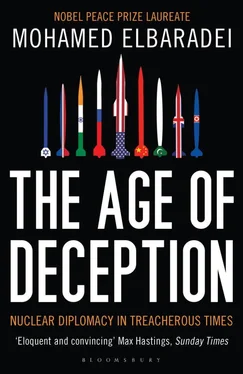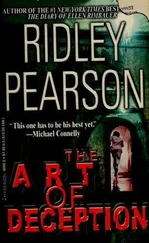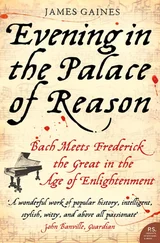Western media organizations were even invited for tours of North Korea’s shut-down nuclear plant. In February 2008, CNN’s Christiane Amanpour reported live from the facilities at Yongbyon, declaring that North Korea had “lifted the nuclear veil.” Technicians from the U.S. Department of Energy were on site, Amanpour observed, helping to dismantle portions of North Korea’s nuclear sites. “It seems a far cry from the hostility conjured by the ‘axis of evil.’” The New York Philharmonic, with conductor Lorin Maazel, had landed in Pyongyang—“a small step on the long road to normality,” in Amanpour’s words. [13] “North Korea Lifts Nuclear Veil,” CNN, February 26, 2008.
The IAEA’s official status with North Korea, however, was in something of a limbo state. When asked by the six parties to verify the shutdown of the Yongbyon facilities, we had responded promptly. However, under the terms of the Joint Agreement, the United States had begun to disable North Korea’s facilities without IAEA involvement, preferring to do things bilaterally. I was reluctant to complain too loudly, because the progress toward dismantlement, in and of itself, was encouraging. The IAEA had gotten tacit agreement from the United States that the Americans involved would “observe” the process and keep records to ensure the Agency’s continuity of knowledge, but our inspectors still worried that, if not present throughout dismantlement, they would lose critical threads of information that could make it difficult later to verify the control of nuclear material.
John Rood, the acting U.S. undersecretary of state for arms control and international security, came to see me in Vienna on May 6, 2008. He said the United States hoped to have North Korea provide its nuclear declaration to the Chinese and to have the IAEA verify the declaration, to reinforce that the rapprochement with North Korea was a multilateral rather than a bilateral process. We would be happy to do so, I said, but passed on to him what we had heard from the North Koreans: the United States did not want the Agency involved.
We would agree to carry out the verification regardless, but I wanted Rood to understand the IAEA’s ambiguous position. Some countries, including most of the Europeans and Japan, took the view that North Korea remained a party to the NPT—in which case the IAEA had a legal obligation to verify their declaration. Others, like the United States, believed that North Korea was no longer part of the NPT. In my opinion as a lawyer, it was clear that North Korea had served legal notice of its withdrawal from the NPT in January 2003 and was therefore no longer a party.
I pressed the IAEA Board for clarification of our situation. The parties to the NPT, I said, needed to determine whether North Korea remained a party to the treaty and to provide the Agency with corresponding guidance. For my part, I wanted to be sure that the Agency could not be blamed for not pushing to exercise its responsibilities. I received no response; in fact, the issue remains unresolved to this day.
On June 26, the North Korean authorities had handed over their declaration to China, with extensive documentation describing their country’s past and current nuclear program. One day later, in a symbolic gesture, the demolition of the sixty-foot-high cooling tower from the Yongbyon reactor was witnessed by a small crowd of international journalists and diplomats. Soon after, Chris Hill came to Vienna to brief me on his negotiation with Pyongyang regarding verification modalities. The six parties wanted the Agency to play a leading role, but North Korea was adamantly refusing our involvement. North Korea’s position was coming from the highest levels of government. Some of the North Koreans, it seemed, remembered the Agency inspections of 1993 as a bad experience. I had also heard that North Korea was hoping that an inspection by the six parties would be “verification lite,” in comparison with the Agency’s rigorous approach.
Whatever the case, Hill showed me a draft proposal that suggested that the IAEA was to act as a “consultant as relevant” to the six parties. The actual verification and the assessment of the verification results would be done by the six. The Agency was to work under their “auspices.”
I rejected the terms. I told Hill I could not accept having the IAEA’s verification authority and role compromised in this way. Of course I understood that the six parties wanted the credibility that would come from the Agency’s involvement, but in fact the opposite would occur: the inspections would not be credible if conducted under the auspices of an ad hoc group of countries. Either we would perform verification under the auspices of the international community, as we had done for fifty years, or they could find someone else to do the job. I asked my IAEA colleagues to pass the same message to the other members of the six-party talks.
When I saw a copy of the North Korean declaration, which should have included all nuclear activity, past and present, it was immediately clear that the document was incomplete. It declared the amount of plutonium produced but gave no information about the country’s past nuclear weapons program or the number of weapons—nor did it mention the alleged uranium enrichment activities.
Hill agreed: the North Koreans, he said, would likely continue to hold on to their existing nuclear weapons for as long as possible. Nevertheless, real progress had been made, because at least their weapons program had been frozen at the current level, as a result of dismantling the facilities. Achieving a final resolution would require more time and patience. Even verification of the declared plutonium would no doubt be a lengthy and complex process.
At the time, I took particular note of Hill’s remark that, given Japan’s perception of its own security, some observers were no longer excluding the possibility of Japan rethinking its nuclear weapons status. Hill did not elaborate, and I did not press him on the point. But I remembered that back in October 2006, both the Japanese foreign minister, Taro Aso, and the Liberal Democratic Party policy chief, Shoichi Nakagawa, had suggested opening discussions about a Japanese nuclear weapons program. [14] On October 18, 2006, during a lower house committee session, Foreign Minister Aso said, “It is one idea not to allow discussions or even to talk about [possessing nuclear arms] when a neighbor country is going to have them, but it is important to have various discussions.” The next day he was quoted as saying, “Japan is capable of producing nuclear weapons.” But he added, “We are not saying we have plans to possess nuclear weapons.”
For Japanese scholars, this was a startling development. Japan was a strong supporter of the NPT; even public mention of Japan’s consideration of nuclear weapons capability had long been considered taboo.
This only reinforced my view that, for any country, the consideration of whether to develop, own, or use nuclear weapons is subject to change at any time, depending on how that country understands its current security situation. It can never be ruled out, as long as the option is open. Changes in the perception of national or regional security can be enough to reverse long-standing policy.
The pendulum swung yet again in the summer of 2008. Pyongyang had a falling-out with Washington because the United States had not removed North Korea from its list of states sponsoring terrorism. Under the Joint Agreement, this was the next action-for-action, once North Korea had taken steps to dismantle its facilities at Yongbyon. The problem, I was told, was that the hard-liners in the U.S. administration were hoping to get “something extra” from North Korea before removing the country from the list: specifically, more progress on the verification of the North Korean declaration.
Читать дальше












